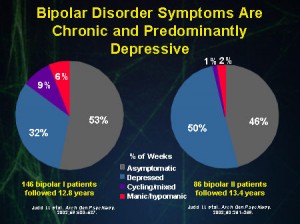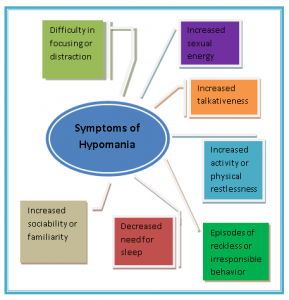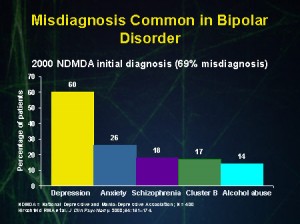
“There is a particular kind of pain, elation, loneliness, and terror involved in the madness of bipolar illness. When you’re high it’s tremendous, you’ve never functioned better. But, somewhere, this changes. The ideas come too fast and are far too many. Confusion replaces clarity, memory goes, and humor and absorption are replaced by fear and concern. Everything previously moving with the grain is now against— you are irritable, angry, frightened, uncontrollable, and enmeshed totally in the blackest caves of the mind that you never knew were there. It will never end, for madness carves its own reality.” Kay Redfield Jamison, An Unquiet Mind: A Memoir of Moods and Madness
Bipolar Disorder in both its forms is a very challenging mental health condition that can negatively affect a person’s work and relationship life, drive, productivity, and self-esteem. People who have the disorder spend a good portion of their time trying to manage shifts in mood, energy and activity levels resulting from their fragile biology. If left untreated the highs and lows of the illness tend to worsen, lowering the chance of leading a full and productive life.
 Bipolar II disorder is referred to as the less extreme form of the illness that can play down the seriousness of the disorder. Although Bipolar I persons struggle more from incapacitating, full-blown mania (delusions and hallucinations) that necessitates hospitalization, Bipolar II persons spend more of their lives depressed and symptomatic.
Bipolar II disorder is referred to as the less extreme form of the illness that can play down the seriousness of the disorder. Although Bipolar I persons struggle more from incapacitating, full-blown mania (delusions and hallucinations) that necessitates hospitalization, Bipolar II persons spend more of their lives depressed and symptomatic.
When it comes to bipolar illness, there is really no such thing as the milder form of the disease. The lengthy periods of bipolar depression in combination with hypomania does not make it easy to live with Bipolar II disorder. In fact, as I point out in today’s post, some aspects of bipolar II illness (prolonged periods of depression) make it more difficult to live with than the first form of the disorder. One thing is for sure, persons who are Bipolar II require the same amount of attention and treatment as those who have Bipolar I disorder.
Why is Bipolar II Disorder Easy to Miss?
Bipolar II disorder is not easy to spot in us or sometimes by professionals. There are many reasons Bipolar II often gets misdiagnosed. First, as mentioned, Bipolar II people spend more time in depression than they do in hypomanic states. This makes it more difficult to see the relationship between one’s depressive and hypomanic states.
Also, bipolar depression can look like a regular major depression. They share many of the same symptoms (e.g., feeling hopeless, sad, chronically tired, mentally sluggish, and loss of pleasure). Nonetheless, there are some important differences between the two that involve character of mood and intensity of symptoms.
Bipolar II depression is more likely to involve irritability, unpredictable mood swings, and thoughts of dying or taking one’s life. The communication between the brain’s nerve circuits shut down that in turn shuts down body processes that makes it difficult for Bipolar II persons to move, speak, and think. The shut down in brain and body chemicals is so profound that the person stops processing information occurring outside of them. This is why there is a greater tendency to develop psychosis in bipolar depression and to experience major disability in work and social functioning. Author Kay Redfield Jamison said it right; bipolar depression enmeshes one in the blackest caves of the mind.
Adding to the diagnostic complexity is that 50% of bipolar people first enter treatment in a depressive episode that leads to 69% misdiagnosis of the disorder. Patients are not always able to provide clinicians with sufficient information to make a bipolar diagnosis, because of a lack of understanding of their mood, energy and activity levels when they feel bad versus good. Clinicians need sufficient samples of cycling of mood and behavior over an extended period of time in order to distinguish depression from bipolar disorder. This is one reason why bipolar illness is not recognized in people until much later in a person’s life (National Institute of Mental Health: Bipolar Disorder).
 Too, their hypomania can appear quite normal. Their mood, energy and activity levels rarely if ever rise to the point of full-blown mania or require hospitalization. They are optimistic, highly productive, interested in people and activities, have a lot of good ideas, mental clarity, and motivated to start new projects. Which of us wouldn’t want to function this way or attribute this state of mind to anything but feeling well?
Too, their hypomania can appear quite normal. Their mood, energy and activity levels rarely if ever rise to the point of full-blown mania or require hospitalization. They are optimistic, highly productive, interested in people and activities, have a lot of good ideas, mental clarity, and motivated to start new projects. Which of us wouldn’t want to function this way or attribute this state of mind to anything but feeling well?
Bipolar II people, also, rarely lose touch with reality in a hypomanic state, no matter how enthusiastic and self-assured they are in happier times. Something very stressful or traumatic has to happen to turn their hypomanic euphoria into full-blown mania.
When we appreciate the extensive length of time Bipolar II persons spend in depression it is easier to appreciate why they respond to better times in their lives much like the groundhog responds to the first sign of spring. It’s time to come out and fulfill goals and dreams they had to put on hold by their depression for months or even years.
It becomes easier to spot Bipolar II disorder in us, if we know the red flags of mood, energy and activity levels that point to the disorder. We also have to remember that when it comes to making the right diagnosis, it is more by contrast of the extremes of sadness versus happiness that the hypomanic character of the “normal” states comes into focus.
A review of mood states over the course of a person’s life reveals the ways in which the periods of hypomania have negatively affected him or her. It is common to find many fits and starts of uncompleted projects. Also, hypomania can lead one to overestimate what is possible, inflated ideas, hypersensitivity, errors of judgment, and short-sighted decisions, all of which compromise work and family relationships and damages reputation and self-esteem.
Bipolar II: Red Flag Checklist
Sometimes we deny symptoms of Bipolar II disorder in us, because we lack understanding of what to look for in our personal history that discloses the disorder. Today, I’m giving you a red flag checklist of aspects of a person’s personal, family, mental health, work and relationship history that may point to a Bipolar II disorder.
1. Have you been depressed since childhood, adolescence or as a young adult? Depression throughout one’s childhood, adolescence and young adulthood is a red flag for bipolar II depression rather than major depression. The pattern of the depressive episodes is important, here. If you have frequent episodes of depression or are sad a lot of the time (at least once a year), there is a strong likelihood that your depression is a part of a bipolar disorder.
2. Is there a genetic basis to your mood disorder? A family history of psychiatric illness, such as a nervous breakdown, alcoholism, depression, mania, or psychosis is also a red flag for bipolar disorder. Is there a parent, sibling, aunt, uncle or cousin who has bipolar disorder or another mood disorder? Has a family member ever been hospitalized for severe depression or mania?
3. Have you been hospitalized for depression or mania? Bipolar II people are rarely if ever hospitalized for their depression or hypomanic behavior. Hospitalization indicates a Bipolar I disorder.
4. Have you had periods of hypomania in your life?
5. Do others see you as the “artistic type” (temperamental, moody, highly strung, quirky, hypersensitive, emotionally fragile or unstable)? Bipolar people are often referred to as sensitive, artistic personalities not just because so many famous entrepreneurs, entertainers, writers, poets, musicians and presidents have the disorder (Famous Bipolar People). Dramatic shifts of mood, energy and activity levels affects one’s attitude and self-image that leads others to see them as fickle, temperamental and moody.
6. Do you have a history of fits and starts of uncompleted projects? Bipolar II persons start many projects in a hypomanic state. They have many good ideas that the negative symptoms of hypomania (hyperactivity, errors in judgment, and distractibility) may not let them complete. Or, bipolar depression takes them over before they can fulfill the projects started in a hypomanic phase.
7. Do you have trouble in work and personal relationships? People with Bipolar II often have difficulty in the workplace. Their swings of mood, energy and activity levels do not allow them to work productively with other people. They may chronically show up to work late or have irregularity of job performance.
8. When you feel well, do you engage in risky behavior? Hypomania can lead to over optimism, faulty judgment and an overinflated self-esteem. This can lead to excessive spending, sexual activity, gambling and alcohol and substance abuse.
9. Are you sensitive to stressful changes? Bipolar II people are very sensitive to internal (illness, hormone shifts, or change in lifestyle habits) and external (job and relationship changes, conflicts, pressures) change. Minor or major change signals their brain to increase or decrease nerve chemicals and hormones that activate a depressed or hypomanic state.
10. Do you frequently fantasize about dying or taking your life? Suicide is a high risk for Bipolar I and II people. The mortality rate for bipolar illness is higher than many forms of heart disease or cancer. As many as 1 in 5 people with bipolar disorder have committed suicide. This is a rate approximately 30 times greater than that of the general population.
If your answers to these questions suggest a Bipolar II disorder, it is very important that you see a trained professional to confirm the diagnosis. Remember, bipolar illness worsens if left untreated. It can be treated and people with the illness can lead full and productive lives. My next article addresses bipolar II treatment. So, stay tuned!
I hope you liked my post today and learned something new you can use in your daily life. If so, please let me know by selecting the Like icon that follows. You can also Tweet or Google+1 today’s post to let your friends know about it. Take good care of yourself. Warm regards, Deborah.







So if someone has most if not all these symptoms that means they have bipolar 2 disorder?
Obviously a check-up with a nearby psychiatrist wouldn’t hurt but still…
Most certainly Ayesha. It is very important to a person’s health to seek professional evaluation and treatment by a psychiatrist or psychologist. Warm regards Deborah.
It’s more that the probability raises that a bipolar disorder may be going on here. What’s most important (and the point you make earlier) that this checklist motivate a person to get the professional help that they need. 🙂
Thank you…
i am student of psychology.and also we regular see or study your posting
Hello Waheed, oh, this is so nice to hear. Congratulations on your excellent field of study. Good to say hello to you today. Warm regards Deborah.
Above questions suggest that I am suffereing from Bipolar II disorder… but I dont think im ever went out of control. What should I say to my doctor? my family and friends are not going to trust me.
Hello Raj, many times people who have Bipolar II disorder do not go out of control. They may have exaggerated behaviors during an up swing of mood, energy and activity levels but they do not become manic and out of control. You may want to bring my article to your doctor and open up the talk by saying that you see some of these symptoms in yourself. Raj, you don’t have to tell your family and friends anything that you don’t want to. In fact, I think it’s good to protect yourself while you are trying to understand if you are or are not Bipolar II. Don’t invite anyone into talks about your mental health who are not supportive and understanding. The most important person is you Raj. Let me know how it goes. Warmly Deborah.
This is yet another great article, Debbie. It clarifies for us a frequently misunderstood disorder, and suggests what to do about it.
thank you so much Sal. Warmly Deborah.
Thank-you, this is one of the best bipolar article’s I have come across along with part 2. I will be sharing this with friends and family and hopefully it will raise awareness and understanding of those around me.
Thanks again love your work 🙂
Thank you so much Elise. I’m really glad you liked these two articles. Raising awareness of the disorder to help those who have it is wonderful. Glad to see you here. Talk with you again. Warmly Deborah.
It’s not hard to see why this could get misdiagnosed! It very obviously shares diagnostic criteria with many mental health conditions, let alone depression as suggested in the article. It does also seem rather broad, however, and I find that disconcerting. For example, the likeness to being an irritable creative type, or sensitive to change. I think everyone is somewhere on a spectrum with change sensitivity, all being being affected to a degree, and as an artist I’ll be the first to note that for many (read: the majority) misanthropy is more of an attractive quality than it is an authentic personality component. But I guess psychiatrists/psychologists and therapists are able to differentiate between patients who are genuinely ill from other, patients who use an idealization of in wellness as a means of manipulation.
So true. It does share so many symptoms with many other disorders including personality disorders. Lisa, that’s interesting. You are right that we have to be able to identify the main symptoms so that we don’t think just because we are sensitive, artistic types that we are bipolar. I agree with you. While it’s true that some people with bipolar II disorder are creative and sensitive types it is not true that all people who are sensitive and artistic are bipolar. So thank you for clarifying this point even more for us. Good to see you here. Warmly Deborah.
(Regardless, I find this fascinating and am very excited about reading other articles on this site? blog? as their titled so relevantly!)
Thank you again. I’m looking forward to your comments Lisa. Warmly Deborah.